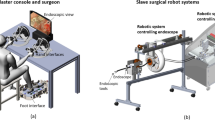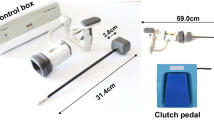Abstract
Purpose
We developed the “Foot-Site Monitor” (FSM) to permit easy identification of multiple foot pedals of energy devices in endoscopic surgery. The purpose of this study was to evaluate the effectiveness of the use of the FSM.
Methods
Using a training box, 20 surgeons performed a task consisting of pressing foot pedals with and without the FSM. The time from showing a color on a PC monitor to pressing the foot pedal that corresponded to this color (defined as the completion time), and the distance of the movement of the tip of the surgeon’s forceps from the beginning to the end of the task (defined as shaking of the forceps) were measured.
Results
The use of the FSM was associated with significantly reduced shaking of the forceps (1.95 vs. 2.47 mm; p = 0.014), and a tendency toward a shorter completion time (1.39 vs. 1.51 s; p = 0.053).
Conclusions
The use of the FSM in endoscopic surgery contributes to reduced shaking of the forceps and may shorten the operative time.




Similar content being viewed by others
Data availability
Raw data were generated at National Cancer Center Hospital East. Derived data supporting the findings of this study are available from the corresponding author (YN) on request.
References
Kamiyoshihara M, Igai H, Ibe T, Kawatani N, Ohtaki Y, Shimizu K, et al. Right superior mediastinal lymph node dissection in thoracoscopic surgery using a bipolar sealing device. Innovations. 2013;8:258–63.
Dural C, Akyuz M, Yazici P, Aksoy E, Aucejo F, Quintini C, et al. Safety and efficacy of a new bipolar energy device for parenchymal dissection in laparoscopic liver resection. Surg Laparosc Endosc Percutan Tech. 2016;26:21–4.
Weyhe D, Uslae VN, Tabriz N, Burkowski I, Heinzel R, Muller A, et al. Experience and dissection device are more relevant than patient-related factors for operation time in laparoscopic sigmoid resection-a retrospective 8-year observational study. Int J Colorectal Dis. 2017;32:1703–10.
Choussein S, Srouji SS, Farland LV, Gargiulo AR. Flexible carbon dioxide laser fiber versus ultrasonic scalpel in robot-assisted laparoscopic myomectomy. J Minim Invasive Gynecol. 2015;22:1183–90.
Gotohda N, Yamanaka T, Saiura A, Uesaka K, Hashimoto M, Konishi M, et al. Impact of energy devices during liver parenchymal transection: a multicenter randomized controlled trial. World J Surg. 2015;39:1543–9.
Richter S, Kollmar O, Schuld J, Moussavian MR, Igna D, Schilling MK, Chirurgische Arbeitsgemeinschaft OP-Technik und OP-Strukturen (CAOP) of the Deutsche Gesellschaft fur Allgemein- und Viszeralchirurgie. Randomized clinical trial of efficacy and costs of three dissection devices in liver resection. Br J Surg. 2009;96:593–601.
Ikeda M, Hasegawa K, Seno K, Imamura H, Beck Y, Sugawara Y, et al. The vessel sealing system (LigaSure) in hepatic resection: a randomized controlled trial. Ann Surg. 2009;250:199–203.
Targarona EM, Balague C, Marin J, Neto RB, Martinez C, Garriga J, et al. Energy sources for laparoscopic colectomy: a prospective randomized comparison of conventional electrosurgery, bipolar computer-controlled electrosurgery and ultrasonic dissection. Operative outcome and costs analysis. Surg Innov. 2005;12:339–44.
Kossi J, Luostarinen M, Kontula I, Laato M. Laparoscopic sigmoid and rectal resection using an electrothermal bipolar vessel sealing device. J Laparoendosc Adv Surg Tech A. 2007;17:719–22.
Milsom J, Trencheva K, Menette S, Pavoor R, Shukla P, Ma J, et al. Evaluation of the safety, efficacy, and versatility of a new surgical device (THUNDERBEAT) in comparison with Harmonic ACE, LigaSure V, and EnSeal devices in a porcine model. J Laparoendosc Adv Surg Tech A. 2012;22:378–86.
Garfinkle R, Boutros M, Hippalgaonkar N, Maimon G, da Silva G, Potenti F, et al. Electrothermal bipolar vessel ligation improves operative time during laparoscopic total proctocolectomy: a large single-center experience. Surg Endosc. 2016;30:2840–7.
Kim YN, Yoo YC, Guner A, Cho I, Kwon IG, Kim YN, et al. Comparison of perioperative surgical outcomes between a bipolar device and an ultrasonic device during laparoscopic gastrectomy for gastric cancer. Surg Endosc. 2015;29:589–95.
Vizzielli G, Conte C, Romano M, Fagotti A, Constantini B, Lodoli C, et al. Clinical impact of a surgical energy device in advanced ovarian cancer surgery including bowel resection. In Vivo. 2018;32:359–64.
Stotz L, Joukhadar R, Hamza A, Thangarajah F, Bardens D, Juhasz-Boss I, et al. Instrument usage in laparoscopic gynecologic surgery: a prospective clinical trial. Arch Gynecol Obstet. 2018;298:773–9.
Jaiswal A, Huang KG. Energy devices in gynecological laparoscopy—archaic to modern era. Gynecol Minim Invasive Ther. 2017;6:147–51.
Matsunaga R, Nishizawa Y, Saito N, Kobayashi A, Ohdaira T, Ito M. Quantitative evaluation of 3D imaging in laparoscopic surgery. Surg Today. 2017;47:440–4.
Rashid TG, Kini M, Ind TE. Comparing the learning curve for robotically assisted and straight stick laparoscopic procedures in surgical novices. Int J Med Robot. 2010;6:306–10.
Sackier J, Wang Y. Robotically assisted laparoscopic surgery: From concept to development. Surg Endosc. 1994;8:63–6.
Buess G, Arezzo A, Schurr M, Ulmer F, Fisher H, Gumb L, et al. A new remote-controlled endoscope positioning system for endoscopic solo surgery: the FIPS endoarm. Surg Endosc. 2000;14:395–9.
Allaf M, Jackman S, Schulam P, Cadeddu J, Lee B, Moore R, et al. Laparoscopic visual field: voice vs foot pedal interfaces for control of the AESOP robot. Surg Endosc. 1998;12:1415–8.
Vara-Thorbeck C, Munoz V, Toscano R, Gomez J, Fernandez J, Felices M, et al. A new robotic endoscope manipulator: a prelim trial to evaluate the performance of a voice-operated industrial robot and a human assistant in several simulated and real endoscopic operation. Surg Endosc. 2001;15:924–7.
van der Voort M, Heijnsdijk EA, Gouma DJ. Bowel injury as a complication of laparoscopy. Br J Surg. 2004;91:1253–8.
Nishimoto W, Kawahira H, Shimomura Y, Nishizawa Y, Ito M. A standing posture support device that reduces laparoscopic surgeons’ occupational lower limb stress. Minim Invasive Ther Allied Technol. 2018;28:151–6. https://doi.org/10.1080/13645706.2018.1491407.
Funding
Funding for this study was provided by Hayashi-Repic Co., Ltd. which is developing products related to the research described in this publication.
Author information
Authors and Affiliations
Contributions
AK, YN, YH and HA collected and interpreted the data. AK and YN interpreted data and wrote the paper, and contributed equally to the manuscript. YH, HA, YT, TS, TK, HD and MI made substantial contributions to the conception and design of the study, and were involved in drafting the manuscript and revising it critically for important intellectual content. All authors declare that they contributed to this article and that they all approve the final submitted version.
Corresponding author
Ethics declarations
Conflict of interest
Dr. Nishizawa received Grants from Hayashi-Repic Co., Ltd.
Additional information
Publisher's Note
Springer Nature remains neutral with regard to jurisdictional claims in published maps and institutional affiliations.
Rights and permissions
About this article
Cite this article
Kondo, A., Nishizawa, Y., Horikiri, Y. et al. A novel device designed to improve the operability of energy devices with foot pedals in endoscopic surgery: the Foot-Site Monitor. Surg Today 49, 965–970 (2019). https://doi.org/10.1007/s00595-019-01824-7
Received:
Accepted:
Published:
Issue Date:
DOI: https://doi.org/10.1007/s00595-019-01824-7




